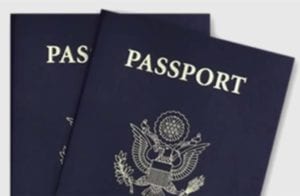When applying for a new or renewed passport there are traps that can cause your trip to end before it starts. Plus, other passport traps cause problems at your destination.
 When traveling internationally, the one document we must have is our passport. Other documents may also be needed for some countries. A few countries have bilateral agreements with the US that permits citizens to use an alternate identification to prove identity and citizenship. Yet only the passport is accepted everywhere US citizens may travel.
When traveling internationally, the one document we must have is our passport. Other documents may also be needed for some countries. A few countries have bilateral agreements with the US that permits citizens to use an alternate identification to prove identity and citizenship. Yet only the passport is accepted everywhere US citizens may travel.
There are five major passport traps to avoid when applying for your new passport or renewal to ensure you can obtain your passport in time for your journey and to help you avoid problems at your destination.
While the passport, as an identification, is universal across the globe, some passport acceptance requirements vary from nation to nation. Moreover, personal information on passports can be abused by government officials in foreign lands.
Submitting a photo that doesn’t match passport photo rules can delay your passport application long enough to miss your trip.
 The Photo Trap:
The Photo Trap:
These days, most everyone has the ability to make their own passport photographs. The U.S. State Department has an easy-to-use, detailed list of the photo’s requirements. Despite that, I’ve heard from too many readers whose passport photos were rejected.
They thought the rules didn’t matter “that much,” but they were wrong. The rules typically broken are the ones concerning background, hats, glasses and, most often, having a neutral face with both eyes open.
Don’t fall into the photo trap. If you’re making your own passport photos:
• Use a white wall or white sheet for your background. Make sure it’s well lighted so it doesn’t show up as gray.
• If you always wear a hat, take it off for the photo.
• If you wear glasses, remove them for the photo.
There are religious exceptions for hats (no shadows on the face) and medical exceptions for glasses (you’ll need a physician to document the condition requiring you to wear them), but they are rare. Generally, just follow the rules.
The neutral face and open eyes is apparently what gets most photos rejected. Many people have a tough time keeping their eyes open with a flash, so try lighting the room without needing one. Once the lighting is nailed, remind the person having their passport photo made to just have a blank look (with their eyes open). No frowns or smiles for this photo. Don’t say, “Cheese!”
You really need to follow all the rules or your photo will be rejected during passport processing.
You can’t fly home using a passport card in case of an emergency. Don’t get trapped out of the country because you don’t have a passport.

It’s true that US travelers can take some international trips using a passport card instead of a U.S. passport. You can use a U.S. passport card for land border crossings and sea ports of entry to Canada, Mexico, many Caribbean countries, and Bermuda.
That said, in case of an emergency, you can’t use your passport card to fly home to the US If you become seriously ill, for example, or someone with whom you’re traveling or someone at home is sick, without a regular passport you’ll at the least be seriously delayed in returning to the U.S. by air — likely by days, maybe longer.
Traveling internationally anywhere? Paraphrasing an old American Express advertisement, “The U.S. Passport, Don’t leave home without it!”
Don’t get caught with too little time left before your journey to obtain a new valid passport.
The Processing Trap:
For too many travelers, “Just in time,” seem to be their motto, including when they apply for a new U.S. passport or renewal. A decade ago, US citizens could apply for a passport renewal at the last minute, They may be confident they could leave on time. That’s not true anymore.
Current processing times for routine passport service are two to three months. Expedited service for an additional fee of $79.53, including one- to two-day delivery, is taking 5–7 weeks at this time. If your trip is imminent, there is an emergency service and private services available. Still, the State Department’s emergency service isn’t fool-proof, and the private services are generally very expensive.
Traveling internationally? Apply for your new passport or renewal well before your journey to be safe.
While you may want to use the new “X” designation for your gender, it could cause severe problems at your destination.
The Gender Specification Trap:
In 2022, to fulfill its promise of equity for all citizens, the U.S. State Department finally added the non-specific gender specification to U.S. passports. U.S. citizens can choose “M,” “F,” or “X” as their gender. I wrote extensively about the then-new specification in my column, Is the US passport’s new gender specification “X” a serious mistake?
While the designation “X” may be a powerful symbol of inclusion for US LGBTQI+ citizens, I continue to seriously question if the designation is helpful for US citizens abroad. Unfortunately, by my count, there are still 69 countries in the world today that have laws that criminalize homosexuality and many other nations in which there is significant, systemized discrimination against LGBTQI+ citizens and visitors.
I understand what it means for many friends to finally not have to check either “M” or “F.” It can engender the feeling they are on the way to having freedom, dignity, and equality. Still, from a practical standpoint, I don’t believe it’s generally a good idea to mark gender with an “X” on a U.S. passport. I am highly concerned that the “X” is tantamount to Nazi Germany’s “J,” something I know a little bit about.

More than 75 countries require your passport to not have expired for 3-6 months after you leave them in order to visit those countries.
The Expiration Trap:
Unfortunately, too many Americans think that every country in the world recognizes their passports’ expiration date to mean that they can be in any foreign country until that date.
Many countries, including most Schengen area countries (most of Europe), require passports to be valid for at least three months beyond the traveler’s date of departure from the Schengen countries they’re visiting. More than 50 countries require passports to be valid for at least six months after a traveler’s entry date or departure. Your passport’s expiration date is crucial for your return to the US.
Check the passport requirements for each destination you intend to visit to know the passport expiration. Know this requirement long before the intended start of your journey. When you fly to a destination, if your passport doesn’t meet the requirements of the destination, your airline won’t let you board. This will end your trip and potentially cost you a great deal of money, at the least.
My rule is to apply for a passport renewal when the expiration date is a year away. That might seem extreme at first, but considering the six-month expiration date rule and three months of processing time, that gives a buffer of only 90 days.
 Each of these passport traps discussed can be avoided with thoughtful preplanning. Take these traps seriously. Ensure that your journey won’t end before it starts.
Each of these passport traps discussed can be avoided with thoughtful preplanning. Take these traps seriously. Ensure that your journey won’t end before it starts.
READ ALSO:
3 ways DOT should post basic passenger travel rights at airports
DOT denied boarding (or bumping) compensation rules you should know
After many years working in corporate America as a chemical engineer, executive and eventually CFO of a multinational manufacturer, Ned founded a tech consulting company and later restarted NSL Photography, his photography business. Before entering the corporate world, Ned worked as a Public Health Engineer for the Philadelphia Department of Public Health. As a well known corporate, travel and wildlife photographer, Ned travels the world writing about travel and photography, as well as running photography workshops, seminars and photowalks. Visit Ned’s Photography Blog and Galleries.



